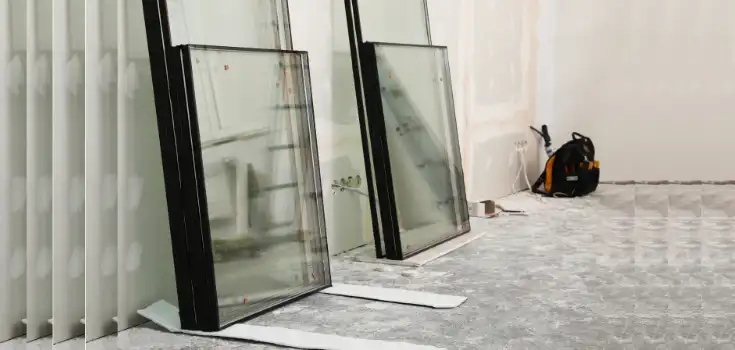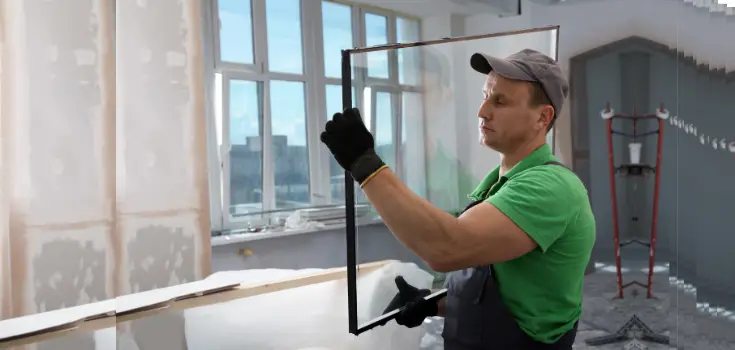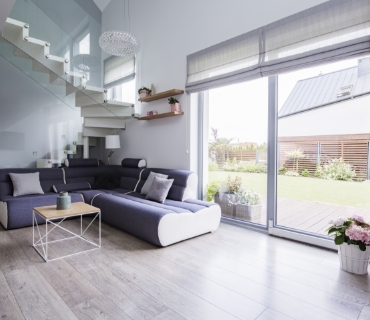Double glazing refers to the use of two panes of glass within a sealed frame, typically separated by an air or gas-filled cavity. This construction creates an insulated glass unit (IGU)—commonly referred to as glazed units—that improves thermal efficiency, reduces noise pollution, and enhances home security.
In 2025, the cost of double glazing depends on multiple factors such as window type, frame material, property size, and installation complexity. This guide breaks down the most up-to-date pricing across the UK and explains what influences these costs — from new installations to window replacements.
🛠️ Note: This article focuses on full-unit double glazing installations, not secondary glazing, which adds a second pane to an existing window.
🏡 Ideal for: Homeowners planning energy-efficient upgrades, landlords improving EPC ratings, and renovators replacing outdated windows.

1. Double Glazing Costs by Window Type and Property Size (UK, 2025)
The windows cost in 2025 depends on various factors including window style, frame material, property size, and the type of glazing selected. Whether you’re replacing a single unit or fitting out an entire home, understanding the pricing structure can help you plan more effectively.
🔲 Window Type Cost Estimates (Per Window)
Based on standard installations with uPVC frames and double-glazed units:
- Casement Windows: £350 – £750
⤷ Simple hinge-opening style, common and cost-effective. - Sash Windows: £700 – £1,500
⤷ Traditional vertically sliding design; ideal for period properties. - Sliding Windows: £500 – £1,400
⤷ Panels slide horizontally; a popular choice for modern homes. - Tilt and Turn Windows: £500 – £1,400
⤷ Dual-function opening; easy to clean and ventilate. - Bay Windows: £900 – £4,000
⤷ Project outward from the building; a stylish yet costly upgrade. - Bow Windows: £1,200 – £5,000+
⤷ A curved version of bay windows; part of premium double glazed window options.
🏡 Whole-House Installation Estimates
- 2 Bedroom House (6–8 windows): £3,000 – £5,000
⤷ This gives a general idea of the cost of double glazing bed house UK for smaller properties. - 3 Bedroom House (8–12 windows): £4,000 – £8,000
⤷ A common size for UK families, this is the average cost of new windows for bed house UK when upgrading. - 4 Bedroom House or Larger: £7,000 – £15,000+
⤷ Larger homes may incur higher new windows cost due to quantity and complexity.
💡 Pro Tip: Large projects may benefit from bulk discounts, but prices rise for custom shapes, finishes, glazed window replacement, or acoustic/security glazing.
📍 Regional Variation
Double glazing prices vary across the UK. Areas like London and the Southeast tend to be more expensive—typically 10–20% higher than the national average—due to labour costs and limited installer availability.
📏 Double Glazing Cost per Square Metre
- Double Glazing Cost per m² (UK average): £150 – £250
⤷ Price varies with glazing specification and frame material.
2. How to Estimate Your Double Glazing Costs (2025)

Wondering what your window upgrade might cost? You can estimate your expected investment using a double glazing cost calculator UK. These online tools generate quick estimates tailored to your home’s size, layout, and design preferences.
🔢 Key Inputs Used by Cost Calculators:
- Property Type & Size
⤷ Number of bedrooms, window count, and overall square footage all factor into new window pricing. - Window Style & Dimensions
⤷ Whether you choose casement, sash, bay, or tilt-and-turn windows, the design has a direct impact on both material and labour costs. - Frame Material
⤷ uPVC (most budget-friendly), aluminium (lightweight and durable), or timber (classic and premium). - Glazing Type
⤷ Choose from standard double glazing, high-performance triple glazing, or specialist acoustic glass. - Location
⤷ Installation rates can vary significantly based on where you live.
📋 Example Calculation (3-Bedroom House):
- 10 uPVC casement windows
- Located in the Midlands
- Standard double glazing
💰 Estimated Cost: £4,200 – £6,000 (including installation)
This range reflects the cost double in a typical mid-size home, and it aligns with many estimates generated by a double glazed windows cost calculator.
💡 Important Tip: These tools provide a general guide only. For the most accurate price, use them as a starting point and always follow up with multiple quotes from trusted local suppliers.
3. What Affects the Cost of Double Glazing?
Several factors influence how much you’ll pay for new double glazed windows. Understanding these variables helps you evaluate quotes and make informed decisions.
1. Frame Material
| Material | Description | Cost Impact |
|---|---|---|
| uPVC | Affordable, low maintenance | £ (Low) |
| Aluminium | Modern aesthetic, very durable | ££ (Medium–High) |
| Timber | Classic look, high upkeep | £££ (High) |
🔍 uPVC is often 20–40% cheaper than aluminium or wood, depending on the window size.
2. Window Style
| Style | Features | Typical Cost Range |
|---|---|---|
| Casement | Hinged at side, most common | £350–£750 |
| Sash | Vertical sliders, traditional style | £700–£1,500 |
| Tilt & Turn | Versatile, inward opening | £500–£1,400 |
| Bay/Bow | Extends outward, panoramic view | £900–£5,000+ |
🧠 Bay windows require more materials and structural work, increasing both product and labour costs.
3. Glazing Type
| Glazing Type | Benefit | Cost Impact |
|---|---|---|
| Double Glazing | Standard for insulation | Base price |
| Triple Glazing | Better insulation & quiet | +20–30% |
| Acoustic Glass | Noise reduction | +30–50% |
| Laminated/Self-Cleaning | Safety or low maintenance | +15–25% |
💡 Triple glazing typically costs £100–£200 more per window vs. standard double glazing.
4. Installation Complexity
- Access issues (e.g. high floors) = higher labour fees.
- Structural changes (e.g. enlarging openings) increase time and cost.
- Custom-fit requirements may require bespoke materials and specialist installers.
5. Location-Based Price Variation
| Region | Typical Labour Rate Trend |
|---|---|
| London & SE | High |
| Midlands | Medium |
| North UK | Lower |
📊 A typical uPVC casement window install in London may cost 15–25% more than the same job in Yorkshire.
6. Energy Efficiency Ratin
- Windows rated A++ offer better insulation but cost more upfront.
- These often pay back in energy savings over 5–10 years.
4. How Much Should You Pay for Double Glazing?

Before committing to a supplier or installer, it’s important to understand how pricing works and to compare multiple quotes to ensure fair value.
📝 Get Multiple Quotes
Always request at least three quotes from reputable suppliers.
Some suppliers offer free, no-obligation quotes.
Comparing quotes helps you identify market price ranges and spot outliers.
⚠️ Beware of Hidden Costs
Removal of old windows can add £100–£300 per unit.
Custom-sized or non-standard windows typically cost more.
Check whether installation costs are included or quoted separately.
🛠️ Understand Your Window Options
Confirm the window frame material and glazing type in each quote.
uPVC frames tend to be more affordable; timber frames usually increase costs.
Also, be sure to review available uPVC window configurations—such as casement, sliding, or tilt-and-turn styles—as these can affect price and performance.
Double glazing is standard, but ask if quotes include optional upgrades like triple glazing or acoustic glass.
📐 Know the Average Cost Ranges for Your Property
| Property Type | Typical Cost Range (UK, 2025) |
|---|---|
| 2-Bed Terraced House | £3,000 – £5,000 |
| 3-Bed Semi-Detached House | £2,800 – £10,000 |
| 4-Bed Detached House | Up to £15,000+ |
💡 Larger homes and premium materials increase total costs significantly.
🔍 Use Online Cost Calculators
Utilize online double glazing cost calculators to get instant estimates tailored to your home size, location, and window types.
Websites like The Eco Experts provide reliable and updated tools.
✅ Summary:
- Always compare multiple quotes.
- Understand what’s included in each quote.
- Check for extra fees (removal, customization, upgrades).
- Use online tools for ballpark estimates.
- Choose options based on your budget and desired quality.
5. Types of Windows That Can Be Double Glazed
Several window styles support double glazing. Each design offers different benefits in terms of ventilation, aesthetics, energy efficiency, and cost. Here’s a breakdown:
🔲 Casement Windows
- Definition: Hinged on one side and open outward like a door.
- Best for: Modern homes seeking efficient airflow.
- Cost Range (2025): £350 – £750 per window.
- Double Glazing Note: Easy to seal tightly for high insulation.
🔳 Sash Windows
- Definition: Panels that slide vertically or horizontally.
- Best for: Period homes and traditional aesthetics.
- Cost Range: £700 – £1,500+
- Double Glazing Note: More complex to retrofit; often more expensive.
🌀 Tilt and Turn Windows
- Definition: Can open inward from the side or tilt from the top.
- Best for: Modern interiors, safety-conscious homeowners.
- Cost Range: £500 – £1,400
- Double Glazing Note: Supports excellent ventilation and insulation balance.
🪟 Bay Windows
- Definition: Projects outward from the wall to create a small nook.
- Best for: Maximizing light and space in living rooms or kitchens.
- Cost Range: £900 – £4,000+
- Double Glazing Note: Larger surface = higher glazing costs.
🏛️ Bow Windows
- Definition: Curved version of bay windows with more panels.
- Best for: Panoramic views and a decorative touch.
- Cost Range: £1,200 – £5,000+
- Double Glazing Note: Custom builds increase labour and materials cost.
💡 Tip: All the above types can be manufactured in uPVC, aluminium, or timber frames — affecting cost and durability.
6. Which Type of Double Glazing is Best?
The best double glazing depends on your budget, property type, and goals — whether that’s lowering bills, reducing noise, or enhancing aesthetics.
Let’s break it down:
⚙️ 1. Frame Materials Comparison
| Frame Type | Pros | Cons | Ideal For |
|---|---|---|---|
| uPVC | Low cost, low maintenance, energy efficient | Limited colour/style options | Most homeowners, buy-to-let |
| Aluminium | Sleek modern look, highly durable | Less thermally efficient unless thermally broken | Contemporary homes |
| Timber | Traditional charm, heritage-friendly | Expensive, regular maintenance needed | Listed buildings, high-end homes |
🧊 2. Glazing Type Comparison
| Glazing Type | Benefits | Drawbacks | Best Use Cases |
|---|---|---|---|
| Double Glazing | Energy efficient, cost-effective | Less insulation than triple glazing | Standard domestic use |
| Triple Glazing | Superior insulation, quieter home | Heavier, more expensive | Cold climates, high-traffic areas |
| Acoustic Glazing | Blocks noise (up to 40dB+) | Higher cost, limited frame compatibility | Near motorways, airports, city centres |
| Laminated Glass | Safety and security | Pricier than standard glazing | Ground floors, families with kids |
| Self-Cleaning Glass | Low maintenance | Less effective in shaded areas | Conservatories, hard-to-reach windows |
📊 Recommendation Matrix
| Goal | Best Frame | Best Glazing |
|---|---|---|
| Budget-Friendly | uPVC | Standard Double |
| Low Maintenance | Aluminium/uPVC | Self-Cleaning |
| Heritage Property | Timber | Slimline Double |
| Noise Reduction | uPVC/Aluminium | Acoustic/Triple |
| Sustainability | Timber (FSC) | Triple Glazing |
🔍 Pro Tip: Check for energy ratings (e.g., A++ to E) and ensure the product is BFRC certified to guarantee performance.
7. Glass Upgrades: Should You Upgrade from Standard Double Glazing?
Not all glass is created equal. Upgraded glazing options offer added performance in key areas such as safety, noise control, maintenance, and energy efficiency. Here’s how each upgrade works—and when it’s worth the investment.
🔍 1. Laminated Glass (Safety & Security)
What it is: Two panes bonded by a plastic interlayer.
Benefits:
- Shatter-resistant: Stays in place when broken.
- Ideal for burglary resistance or high-impact zones.
Use Cases:
- Ground-floor windows
- Homes with children
- Security-conscious buyers
Extra Cost Estimate: +15–25% over standard glazing
🔇 2. Acoustic Glass (Noise Reduction)
What it is: Thicker or layered glass designed to block soundwaves.
Benefits:
- Reduces external noise by up to 40 dB
- Improves sleep and concentration indoors
Use Cases:
- Properties near busy roads, train tracks, or airports
- Home offices or nurseries
Extra Cost Estimate: +20–30% over standard glazing
🧼 3. Self-Cleaning Glass (Low Maintenance)
What it is: Coated with a special hydrophilic layer that breaks down dirt and allows rain to wash it away.
Benefits:
- Saves time on window cleaning
- Maintains a clearer view longer
Use Cases:
- Hard-to-reach windows
- Conservatories, skylights
Extra Cost Estimate: +10–15% over standard glazing
❄️ 4. Low-E (Low Emissivity) Glass (Energy Efficiency)
What it is: Glass with a special coating that reflects heat back into the room.
Benefits:
- Improves thermal insulation
- Reduces heating bills
Use Cases:
- Any energy-conscious renovation
- Cold climates
Extra Cost Estimate: +5–10% over standard glazing
🎯 Summary Comparison Table
| Glass Type | Core Benefit | Best For | Price Uplift |
|---|---|---|---|
| Laminated | Security | Ground floors, kids’ rooms | +15–25% |
| Acoustic | Noise reduction | Near traffic, airports, offices | +20–30% |
| Self-Cleaning | Low maintenance | Conservatories, skylights | +10–15% |
| Low-E | Energy savings | All homes, colder regions | +5–10% |
🧠 Expert Tip: Most upgrade types can be combined. For example, laminated acoustic glass offers both security and noise reduction in one unit.
8. Complete Double Glazing Project Checklist
Before you sign a contract or place an order, use this structured checklist to ensure nothing is missed. This framework guides you from evaluation to execution:
🏠 Assess Current Windows (Pre-Installation Phase)
✅ Identify how many windows need replacement
✅ Determine which are single vs. double glazed
✅ Check for existing damage, draughts, or condensation
✅ Measure window sizes for estimation tools
🛠️ Define Upgrade Priorities (Needs Analysis)
✅ Prioritize your goals:
- 💷 Energy savings
- 🔇 Noise reduction
- 🔒 Security
- 🧼 Low maintenance
- 🎨 Style or curb appeal
✅ Choose appropriate frame material (uPVC, timber, aluminium)
✅ Decide on glazing type (double, triple, acoustic, laminated, etc.)
🧑🔧 Vet Suppliers and Installers (Due Diligence)
✅ Research at least 3–5 certified installers (check FENSA or CERTASS accreditation in the UK)
✅ Compare product warranties (look for 10+ years as standard)
✅ Ask about after-sales service and response time
✅ Request written itemised quotes—avoid verbal estimates
🧾 Budget and Financial Planning
✅ Use a double glazing cost calculator to project your spend
✅ Budget for both materials and labour (separately)
✅ Include contingencies (e.g., unexpected installation complications)
✅ Explore grants or energy-efficiency funding if available (e.g., ECO4, Green Deal)
📑 Check Legal & Regulatory Requirements
✅ Check if you need planning permission—especially for:
- 🏡 Listed buildings
- 🏛️ Properties in conservation areas
- 🧱 Flats with leasehold restrictions
✅ Ensure compliance with UK Building Regulations (especially Document L for energy efficiency)
🚚 Plan the Installation Process
✅ Confirm installation schedule and lead times
✅ Ensure access is available to all window locations
✅ Ask about waste removal and site cleanup
✅ Understand what to expect during the fitting (disruption, noise, etc.)
✅ Final Pre-Check Summary Table
| Checklist Stage | Key Actions |
|---|---|
| 1. Current Assessment | Audit windows, sizes, issues |
| 2. Goals & Priorities | Define benefits needed, glazing types, materials |
| 3. Supplier Vetting | Validate certifications, warranties, reviews |
| 4. Financial Planning | Budget setup, grants explored, contingencies included |
| 5. Legal Compliance | Check if permissions or special regulations apply |
| 6. Installation Logistics | Confirm timing, site readiness, post-install cleanup |
🧠 Pro Tip: Print this checklist and take it to your supplier meeting. It helps ensure they address all the key variables that affect cost and satisfaction.
Conclusion
Double glazing remains one of the most impactful ways to boost your home’s comfort, energy performance, and resale value.
By understanding how prices vary by window style, materials, house size, and installation complexity, you can plan your investment with confidence — and avoid costly surprises.
✅ Whether you’re replacing outdated windows or upgrading for soundproofing and warmth, make sure you compare at least 3 quotes and consider energy-efficient options like triple glazing or acoustic glass if they suit your home.
📞 Have questions or ready to take the next step? get a double glazing quote from a trusted professional to explore your options, understand the costs, and receive expert advice tailored to your home before making any commitments.
FAQs
Cost of double glazing a 2 bed house uk, average cost of double glazing 2 bed house, cost of double glazing 2 bed terraced.
Typical cost of double glazing, average double glazing cost uk, rough cost of double glazing.
The average cost of double glazing per window ranges between £350 and £750 for casement windows. Sash and bay windows can exceed £1,000.
Cost of double glazing a 4 bed house uk, how much is double glazing for a 4 bed house.
Factors such as the window UPVC material, glazing type, window style, installation complexity, and location influence windows double glazing cost.
The average cost of double glazed windows UK-wide is between £4,000 and £7,000 for a standard 3-bedroom house. This varies based on design, materials, and labour.


